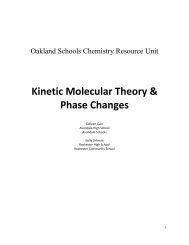Oakland Schools ASSISTIVE TECHNOLOGY GUIDELINES
Oakland Schools ASSISTIVE TECHNOLOGY GUIDELINES
Oakland Schools ASSISTIVE TECHNOLOGY GUIDELINES
Create successful ePaper yourself
Turn your PDF publications into a flip-book with our unique Google optimized e-Paper software.
Remember that the field of assistive technology is a new one. Our knowledge of what works and what<br />
doesn't continues to evolve as we gain a better understanding of how these tools can be wed to<br />
facilitate a child's independence and maximize integration. As a professional or a family member who will<br />
be involved in the daily integration of technology, your contribution to the field's knowledge base can be<br />
invaluable. Approach each potential technology user's educational program with an open yet critical<br />
mindset. Don't fall into the trap of applying standard strategies to each case. Be flexible in your approach<br />
and creative in your programming. Be willing to try anything at least once. And most of all, keep a sense<br />
of humor.<br />
Functionality and Independence Across All Life Environments<br />
• What is an environmentally based approach to program development?<br />
Within the last decade, there has been a dramatic shift in the way teachers approach the development<br />
of educational programs for children with severe disabilities. No longer is learning viewed as a six-hour<br />
experience that occurs within the physical confines of the classroom. Instead, it is seen as a dynamic<br />
process that is based on the give-and-take interactions of individuals with the world around them. As a<br />
result, the design of educational programs has taken a new focus. Emphasis is placed on developing a<br />
student's skills and behaviors required for functional independence and successful integration in all<br />
present and future settings.<br />
An environmentally based method of teaching involves the identification of specific skills and tasks that<br />
will facilitate improved independence and maximize integration. In this approach, the learning<br />
environments of home and community are considered as important to learning as the school situation.<br />
The proportion of learning that occurs in the classroom as compared to the learning that occurs in the<br />
home and community varies according to the student, the task, and the practicality of moving about in<br />
multiple, natural settings.<br />
• Does the environmentally based approach fit in with my current teaching philosophy?<br />
An environmentally based approach to program planning might require some adjustment in the way<br />
you approach teaching. The educational philosophy presented herein does not build upon traditional<br />
curricula, and the developmental model upon which many early childhood education programs are<br />
based is not inherent in this approach. Instead, this teaching philosophy requires the development of a<br />
unique curriculum for each child that looks at future goals as well as current learning. However, in spite<br />
of their uniqueness, environmentally based approaches are compatible with traditional teaching<br />
philosophies. Using this strategy in addition to your existing curriculum will enhance and enrich the<br />
learning experiences of each student.<br />
The approach is not new to the field of special education. It is well-grounded in theoretical and empirical<br />
literature. It can stand alone as an educational program or it can enhance the traditional curriculum. The<br />
environmentally based model of instruction is a "thinking" curriculum in that it relies on the teacher to<br />
develop and adjust the educational experiences of each student based on his or her needs in each<br />
learning situation. As such, it is particularly applicable to the inclusion of highly specialized devices and<br />
techniques.<br />
• Why should I use an environmentally based approach to develop goals for my students?<br />
The goals of the Individualized Education Program for students with disabilities are typically derived<br />
from the results of diagnostic evaluations. Information obtained from these traditional assessment<br />
procedures, however, rarely help the teacher decide how to use technology as a tool to achieve<br />
educational objectives. There are serious limitations to traditional diagnostic assessment procedures:<br />
– Norm-referenced tests provide only a standardized measurement of a person's performance<br />
relative to the performance of others.<br />
– Intelligence scales only sample and compare behaviors against the norm to determine an<br />
intelligence quotient.<br />
Appendix B, page 4
















